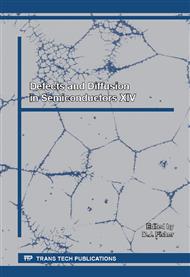[1]
H. Zhou, M. Suzuki, G. Randers-Pehrson, D. Vannais, G. Chen, C.A. Waldren, T.K. Hei, Proceedings of the National Academy of Sciences of the United States of America (PNAS), 98.
Google Scholar
[2]
A. Atul Kulkarni, C.K. Vyas, H. Kim, P.C. Kalsi, T. Kim, V. Manchanda, Online optical monitor of alpha radiations using a polymeric solid state nuclear track detector CR-39, Sensors and Actuators B, 161 (2012) 697-701.
DOI: 10.1016/j.snb.2011.11.016
Google Scholar
[3]
R.L. Fleischer, P.B. Price, R.M. Walker, Nuclear Tracks in Solids, University of California Press, Berkeley, CA, (1975).
Google Scholar
[4]
L.H. Sperling, Introduction to Physical Polymer Science, John Wiley & Sons, Inc., (2006).
Google Scholar
[5]
A. Dupasquier, A.P. Mills, Editors, Positron Spectroscopy of Solids, North-Holland, Amsterdam, (1995).
Google Scholar
[6]
Ismayil, V. Ravindrachary, R.F. Bhajantri, S.D. Praveena, B. Poojary, D. Dutta, P.K. Pujari, Optical and microstructural studies on electron-irradiated PMMA: a positron annihilation study, Polymer Degradation and Stability 95 (2010) 1083-91.
DOI: 10.1016/j.polymdegradstab.2010.02.031
Google Scholar
[7]
B.L. Evans, The microhardness of injection moulded polystyrene and polyethylene. Journal of Materials Science, 24 (1989) 173-82.
Google Scholar
[8]
P.K. Dubey, R. Bajpai, J.M. Keller, Structural, morphological and microhardness characterization in polymer complex of laser dye rhodamine (Rh6G) doped polymethyl methacrylate, Microsyst. Technol., 14 (2008) 1165-71.
DOI: 10.1007/s00542-008-0650-z
Google Scholar
[9]
W. Enge, Introduction to plastic nuclear track detectors. Nuclear Tracks, 4 (1980) 283-308.
Google Scholar
[10]
M.F. Eissa, Optical properties of CR-39 track etch detectors irradiated by alpha particles with different energies. Journal of Materials Science and Engineering, 5 (2011) 26-31.
Google Scholar
[11]
E.H. Lee, G.R. Rao, L.K. Mansur, LET Effect on cross-linking and scission mechanisms of PMMA during irradiation, Radiation Physics and Chemistry, 55 (1999) 293-305.
DOI: 10.1016/s0969-806x(99)00184-x
Google Scholar
[12]
F. Ziegler, SRIM-2008, available online at: www. SRIM2008. org.
Google Scholar
[13]
J. Kansy, Programs for positron lifetime analysis adjusted to the PC Windows environment. Materials Science Forum, 363-365 (2001) 652- 4.
DOI: 10.4028/www.scientific.net/msf.363-365.652
Google Scholar
[14]
S.J. Tao, Positronium annihilation in molecular substances. Journal of Chemical Physics, 56 (1972) 5499-510.
Google Scholar
[15]
M. Eldrup, D. Lightbody, N. Sherwood, The temperature dependence of positron lifetimes in solid cyclohexane. Journal of Chemical Physics, 63 (1981) 51-8.
DOI: 10.1016/0301-0104(81)80307-2
Google Scholar
[16]
H. Nakanishi, S.J. Wang, Y.C. Jean in S.C. Sharma (Ed. ). Positron Annihilation Studies of Fluids, World Scientific, Singapore, (1988).
Google Scholar
[17]
Y.Y. Wang, H. Nakanishi, Y.C. Jean, T.C. Sandreczki, Positron annihilation in amine-cured epoxy polymers - pressure dependence, Journal of Polymer Science B, 28 (1990) 1431-41.
DOI: 10.1002/polb.1990.090280902
Google Scholar
[18]
R. Kumar, S. Rajguru, D. Das, R. Prasad, SHI induced modification in CR-39 polycarbonate by positron annihilation lifetime studies, Radiat. Meas., 36 (2003) 151-4.
DOI: 10.1016/s1350-4487(03)00113-6
Google Scholar


